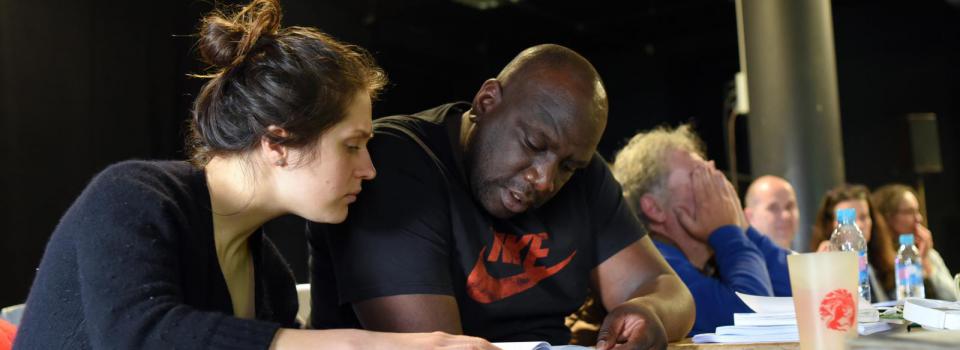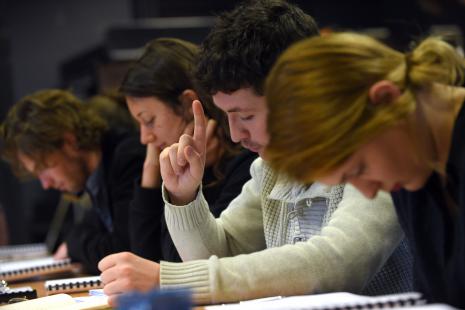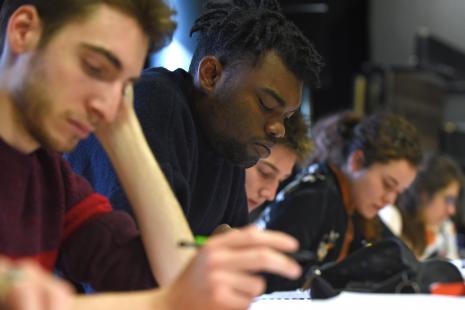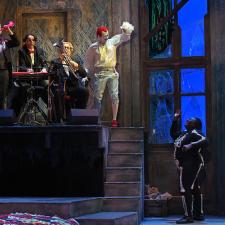
# 5 DOM JUAN OR THE FEAST WITH THE STATUE
By Yannick Cotten
The creative team behind DOM JUAN OR THE FEAST WITH THE STATUE share diary entries about their new show.
Working on The Feast with the Statuehas given us, the students of the 9thcohort of Académie de l’Union, the rare and formative opportunity of discovering how theatre shows are made.
First, we had a chance throughout our training at the school of working at the kind of pace we would later be working at, in this profession we were preparing to enter. Rehearsals started mid-way through our first year, and continued throughout our time at the school. This project has made us aware of life after drama school, it has given an objective to our training and a way for us to actually experience what we trained for. Through this production, we have met professional artists, which inevitably led to some sort of mentoring. Under the watchful eye of these more experienced people, we continually discovered what was at stake in becoming a professional artist. This is different to the way we are taught at the school, where we are protected and kept away from the job’s constraints, so that we can all individually blossom as the artists of tomorrow.

This hasn’t always been easy: the demands made by these seasoned actors or directors were sometimes in conflict with our budding artists’ visions and habits. We have continually had to learn how to best use the different tools we had acquired during our training whilst also being free and ready to meet the show’s demands. In this show, actors must be ready!
Of course, this happened gradually, throughout the rehearsal process and as we were getting closer to finishing our training. First, we started by doing readings of the play. Then, we discovered the first edits of the text and how unique Dom Juan is as a myth. We also became progressively immersed backstage in this major production. Later, one of our pedagogues, Jerzy Klezyk, prepared us for this acting challenge in one of the rehearsals. But during the creative process, ideas of training and pedagogy started to disappear and instead, we focused on stage directions and discovered what professional actors conscious of their craft are expected to do.

Discovering Molière’s text was another key point for us. As stage material, it is complex, which meant we approached our craft in a way with which our work at the school can’t compare. Each play text is a discovery, a well of learning that transforms us and with which we have to collaborate in order to perform it. Until then, we hadn’t studied Molière at Académie de l’Union.
Molière’s text, with its layers, and Jean Lambert-wild and Lorenzo Malaguerra’s casting choices, have been a long-term undertaking. We have continually explored different options, making suggestions that were either accepted or rejected, at times tolerated for a while and often abandoned later… It has been a constant challenge for us to slowly but surely get closer to our shared point of view: the confrontation between Dom Juan and death. The men of the 9th cohort are cast as Dom Louis and the Beggar, the women as Donna Elvira and Charlotte, the peasant woman that Dom Juan seduces. Below, some thoughts on our work on the male characters. Another diary entry will focus on the female characters.
First, Dom Louis, and the fact that it is difficult to play Dom Juan’s father while we are all aged between 20 and 27 years old. This phase of research was long and arduous. Together, we looked for a stage solution to this basic age problem. We spent long rehearsal sessions entirely on this and on the fact that we were having difficulty finding our “paternal instinct”. We tried everything: realism (awaking in ourselves the type of charisma that only a father can have with his son), or more far-fetched ideas, based on the overall dramaturgical decisions, where the character seems nervously exhausted and completely at the end of his tether in front of his son’s downward spiral. For this, the phantasmagorical staging helped us greatly, especially when we thought Dom Louis should wear the same make-up as his son: his face painted white. This idea, which we kept, immediately suggested a filial relationship with Dom Juan. It also made it easier for the actors who play him, since apart from his age, what is at stake in this scene can be the same for a young or an older person.

Other, completely different problems arose with the Beggar. First, we thought it would be risky to play this scene straightforwardly. We had to find a radical point of view to highlight this scene’s unique position in the show. We quickly decided to approach it through clowning, to show this character’s special status in the narrative and his situation, undeniably on the margins of society. Making the Beggar a clown was another way of connecting him to Dom Juan. It became a filial relationship that wasn’t made by blood, unlike the one with Dom Louis, but by a way of thinking and living. This might sound paradoxical since Dom Juan is disdainful of anyone who is a believer, but the Beggar is the only one whom the seducer respects. This is because they have both chosen freedom. Dom Juan sees how the Beggar doesn’t grapple with the turpitudes human society creates in everyone and against which he constantly fights. Maybe he sees in him another knight, a knight of faith, but a knight nevertheless. While we kept the idea of the Beggar as a clown for a while, we eventually thought it was wiser to go back to basics with this scene, to its almost confounding simplicity. We then realised that our foray into clowning was giving the scene with the Beggar a completely different dimension. No sleight of hand, no novel staging ideas were necessary for it to work. The actors’ craft, alone, aided by the original and unique text and our acting intention, subtle yet coherent with what surrounds us, meant we could find the Beggar and his exceptional dimension as the one who rejects money so as to not abandon Dom Juan to damnation.

- Carnet de bord # 1 Dom Juan ou Le Festin de pierre
- Carnet de bord # 2 Dom Juan ou Le Festin de pierre
- Carnet de bord # 3 Dom Juan ou Le Festin de pierre
- Carnet de bord # 4 Dom Juan ou Le Festin de pierre
- Carnet de bord # 5 Dom Juan ou Le Festin de pierre
- Carnet de bord # 6 Dom Juan ou Le Festin de pierre
- Carnet de bord # 7 Dom Juan ou Le Festin de pierre
- Carnet de bord # 8 Dom Juan ou Le Festin de pierre
- Carnet de bord # 9 Dom Juan ou Le Festin de pierre
- Carnet de bord # 10 Dom Juan ou Le Festin de pierre
- Carnet de bord # 11 Dom Juan ou Le Festin de pierre
- Carnet de bord # 12 Dom Juan ou Le Festin de pierre
- Carnet de bord # 13 Dom Juan ou Le Festin de pierre
- Carnet de bord # 14 Dom Juan ou Le Festin de pierre
- Carnet de bord # 15 Dom Juan ou Le Festin de pierre
- Carnet de bord # 16 Dom Juan ou Le Festin de pierre
- # 5 DOM JUAN OR THE FEAST WITH THE STATUE
- # 7 DOM JUAN OR THE FEAST WITH THE STATUE

